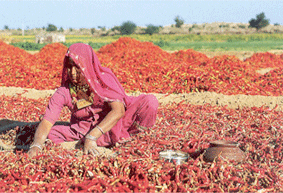
Welcome |
|
|
|
|
|
|
|
|
|
|
|
|
|
|
|
|
|
|
|
|
|
|
|
|
|
|
|
|
|
|
|
|
|
|
|
|
|
|
|
|
|
|
|
|
|
|
|
|
|
|
|
|
|
|
|
|
|
|
|
|
Rajasthan is
one of the least densely populated states in India. It is
also one of the poorest state with low per capita income and
low level of literacy, specially in women. The economy of
Rajasthan is agricultural or pastoral economy. Besides this,
there are good mineral resources, industries, industrial
areas and an expanding tourism industry in Rajasthan. |
|
|
Agriculture
in Rajasthan |
|
 |
The total sown area of Rajasthan is about 20 million
hectares, out of which only 20% of the land is irrigated.
Rajasthan receives very less rainfall and due to this, the
farmers have to depend on the various other sources of
irrigation.
There are mainly two crop seasons - Rabi and Kharif season. The Rabi crops
are sown in October and November and harvested in March and April.
These crops are wheat, barley, pulses, gram and oil seeds. The
Kharif crops are sown in June and July and harvested in September
and October.
|
|
These crops are Bajra, Jowar,
Pulses, Maize and Ground nut. Improved, high-yielding varieties
of rice are also grown in the areaswith
large water supply. Rape and mustard are the most
important oil seeds. Cotton is an important cash
crop which is grown in the north and south parts
of the state. The fruits and vegetables are also
grown throughout the state. The main fruit trees
are orange, lemon, pomegranate, guava and mango.
The main source of irrigation are wells, tube
wells and tanks. Rajasthan receives water from the
Punjab rivers in the North, the Narmada in the
South and from the Gurgaon and Agra Canals from
Haryana and Uttar Pradesh. |
|
|
|
|
Minerals of
Rajasthan |
|
Rajasthan has the second largest mineral resources in India.
Rajasthan produces 42 varieties of major minerals and 23 varieties
of minor minerals. The major minerals include Copper, Zinc,
Gypsum, Clay, Soap Stone, Asbestos,
Fluorite, Feldspar, Ball Clay and Rock Phosphate. Rajasthan
is the second largest producer of glass, clay, silica and ceramic and the leading producer of feldspar,
zinc and emeralds. It also produces 94% of India's gypsum,
76% of silver ore, 84% of asbestos, 68% of feldspar and 12%
of mica. The rich salt deposits are found at Sambhar and
other places and copper mines at Khetri and Dariba. The
white marble is found in Makrana, near Jodhpur. |
|
|
|
Industries in Rajasthan
|
|
The
industrial development in Rajasthan was started between 1950
and 1960. Large business groups like the Birlas, the Shrirams
and the Singhanias have set up large scale projects in Rajasthan. National Engineering Industries,
J K Synthetics and Rayon industries are the main industries that
have been set up in Rajasthan. Today, almost all prominent groups including
Thapars, Modis, Goenkas, Bangurs, Poddars and Rankas have a manufacturing base in Rajasthan.
Large number
of small scale and large scale industries have been set up in
Jaipur, Kota, Udaipur and Bhilwara in Rajasthan. Chambal Fertilizer project, Shriram
Chemicals and Fertilizers Ltd. and Ashok Leyland Ltd. are the
small scale industries that have been set up. The
area of Rajasthan is rich in zinc, copper, gypsum, lignite and mica.
So as to make a proper use of them these metals are exploited and
industries have been developed. The main industries are based on
textiles, rugs, woollen goods, vegetable oil and dyes. Various cotton and textile industries
have also been set up in several places in Rajasthan. The
other private sector industries include the steel, cement, ball bearings,
ceramics, sugar, electrical, electronics, tourism and other chemical
industries. |
|
|
| Industrial
Areas in Rajasthan
|
|
Around 212 industrial areas
covering
an area of about 42000 acre have been set up at strategic
locations which are equipped with electricity, water and telecommunication services.
Shahjahanpur, Neemrana, Behror, Khushkhera, Jurhera in Bharatpur district
and Bhiwadi Industrial Area are the best industrial estates in
India. Industrial areas at Abu Road, Udaipur and Banswara in South
Rajasthan are the ideal locations for mineral based projects.
Sitapura, Malviya and
Vishwakarma industrial areas have been set up in Jaipur which
are equipped with excellent social infrastructure. Export Promotion
Industrial Park has been set up in Sitapura and Bhiwadi in
Rajasthan. |
|
|
| Tourism in
Rajasthan |
|
Tourism makes a large contribution to the economy of
Rajasthan. Recent hike in the figures of tourists to
Rajasthan has proved that tourism is a vital source of
income for the state of Rajasthan. One may not forget that
many heritage Hotels (Old forts and Palaces) all over
Rajasthan are being run successfully for handsome amount of money and
the considerable amount of tax being paid to the state
government support the local
economy and people of Rajasthan which would have not been possible
without the tourists visiting the state. A recent study
showed that from every single tourist around 13 people
profit directly or indirectly. Local transporters, Hotels,
Shopkeepers,
Monuments, Museums, Guides, Tour Operator just to name a few who
survive through tourists.
If proper efforts
are taken, then around 30% of the total population of
Rajasthan can live from tourism. Rural tourism in Rajasthan
could bring enormous wealth to the villages of Rajasthan but
due to lack of infrastructure and basic problem of the
society it does not seem very promising in near future
though the local government would always make self
glorifying statements to gain popularity
among the villagers. The other
unfortunate factor is that the increase in the cost of per
night stay for tourist may not make Rajasthan in long term
an attractive destination. |
|
|
|
|
|
|